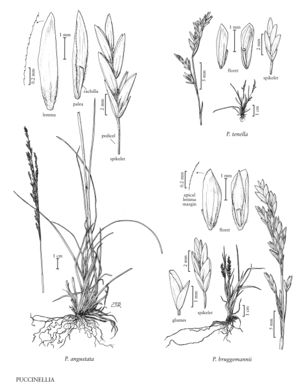Puccinellia angustata
Plants perennial; cespitose, not mat-forming. Culms 10-35 cm, erect to decumbent. Ligules (0.8)1-3(4) mm, acute, obtuse, or truncate, entire; blades usually involute and 0.5-1.2 mm in diameter, sometimes flat and 0.5-3 mm wide. Panicles (4)5-10(13)cm, usually contracted, occasionally diffuse at maturity, lower nodes with 2-3(4) branches, lower branches erect to ascending, spikelets usually confined to the distal 1/2; pedicels scabrous, lacking tumid epidermal cells. Spikelets 4-10 mm, with 3-5(6) florets. Glumes rounded over the back, veins obscure, apices acute; lower glumes 1.5-2.8 mm, usually less than 1/2 as long as the adjacent lemmas; upper glumes 2.2-4.2 mm; rachilla internodes slightly and gradually broadened to the point of attachment with the lemmas, at least the lowest internode usually more than 0.09 mm thick; calluses with a few hairs; lemmas 3.5-5.2 mm, herbaceous, often purplish, hairy on the proximal 1/2 along the veins, sometimes also between the veins, backs rounded, 5-veined, veins obscure, not extending to the margins, apical margins hyaline, scabrous, apices acute, entire or erose; palea veins with curly, intertwined hairs proximally, scabrous distally; anthers (0.6) 0.8-1.1(1.5) mm. 2n = 42.
Distribution
Alta., B.C., Greenland, Man., N.W.T., Nunavut, Que., Sask., Yukon, Alaska
Discussion
Puccinellia angustata is a common and widespread arctic species that grows in disturbed silty or sandy sediments. It is usually non-littoral, but when in coastal areas it grows above the influence of high tide.
Selected References
None.
